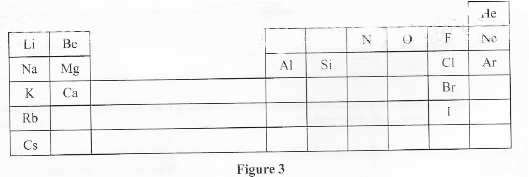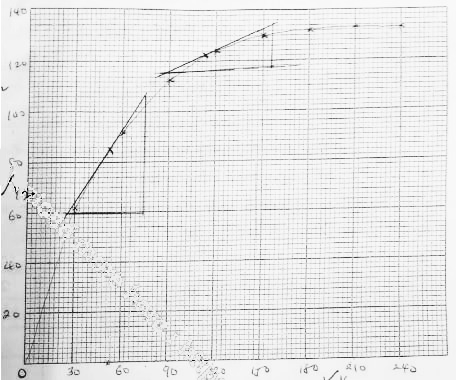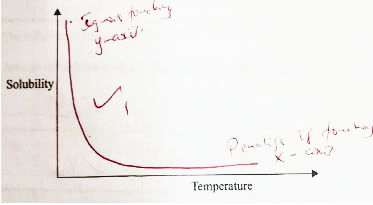QUESTIONS
- Table 1 gives the properties of two compounds, A and B.
- Table 1
State and explain the observation made when each of the compounds is left exposed in air:A B white, crystalline, efflorescent white, crystalline, deliquescent - Compound A (2 marks)
- Compound B (2 marks)
- In an experiment to determine the formula of hydrated magnesium sulphate, a sample was heated in a crucible until a constant mass was obtained. The results are shown in Table 2.
Table 2
Using the information in Table 2, determine the formula of the hydrated saltMass of crucible 25.62 g Mass of crucible + solid before heating 28.08 g Mass of crucible + solid after heating 26.82 g
(Mg - 24.0; S = 32.0; O=16.0; H = 1.0). (3 marks) - Figure 1 shows analysis of an alloy containing two metals.

- Give the name of another product formed in step 1. (1 mark)
- Write the formula of the complex ion present in the colourless solution obtained in step 2 (1 mark)
- Identify the metals in the alloy, (2 marks)
- Table 1
- The flow chart in Figure 2 shows the processes involved in the manufacture of sulphuric(VI) acid.

- Explain how the sulphur used in this process is obtained. (2 marks)
- Give one advantage of using air in chamber 1 instead of using oxygen gas. (1 mark)
- Identify substances: (1)
- M (1 mark)
- N (1 mark)
-
- In chamber 2, drying and purification take place. Give a reason why this is necessary (1 mark)
- The reaction in chamber 3 is highly exothermic.
- Explain why high temperature is required for the reaction in chamber 3. (1 mark)
- State how heat produced in chamber 3 can be utilised in this process
- Give a reason why this method of manufacture is known as 'contact process". (1 mark)
- Emission of gases in the sulphuric(VI) acid plant may lead to environmental pollution.
- State the evidence that could be used to show that the sulphuric(VI) acid plant causes pollution (1 mark)
- Explain how the pollution identified in 2(1)(i) can be controlled. (1 mark)
-
- Chemical reactions occur as a result of collisions of particles. Give a reason why not all collisions are effective. (1 mark)
- State and explain how the following factors affect the rate of reaction:
- Surface area of reactants. (1 mark)
- Pressure. (1 mark)
- In an experiment to determine the rate of a reaction, marble chips were added to excess 2M hydrochloric acid. The equation for the reaction is:
CaCO3(s) + 2HCl(aq) → CaCI2(aq) + CO2(g) + H2O(l)
The volume of carbon(IV) oxide produced was measured at 25°C and recorded after every 30 seconds. Table 3 shows the results obtained.
Table 3
Time (seconds) 0 30 60 90 120 150 180 210 240 Volume of CO2 (cm3) 0 62 92 113 124 130 132 133 133 - On the grid provided, plot a graph of volume of carbon(IV) oxide (vertical axis) against time (horizontal axis). (3 marks)

- Using the graph, determine the rate of reaction at the:
- 45th second. (1 mark)
- 105th second. (1 mark)
- Give a reason for the differences in the two rates. (1 mark)
- Using the graph, determine the mass of marble chips that reacted (2 marks)
(Ca=40.0; C = 12.0; 0 - 16.0;)
Molar gas volume at room temperature and pressure = 24000 cm").
- On the grid provided, plot a graph of volume of carbon(IV) oxide (vertical axis) against time (horizontal axis). (3 marks)
-
- Sea water contains approximately 3% sodium chloride. Describe how sodium chloride is obtained from sea water. (3 marks)
- The solubility of sodium chloride is 36.2 g in 100 g of water at room temperature. Determine the concentration in moles per litre of a saturated aqueous sodium chloride at room temperature (Na= 23.0; Cl= 35.5; density of water = 1.0 gem"). (2 marks)
- Ammonia is highly soluble in water.
- Explain how aqueous ammonia is prepared starting with ammonia gas. (2 marks)
- On the axes provided, sketch a curve showing how solubility of ammonia gas varies with temperature. (1 mark)

- Give a reason for the shape of the curve. (1 mark)
- Water hardness is due to the presence of magnesium and calcium ions. Explain how these ions get into sources of water. (2 marks)
-
- Figure 3 shows part of a Periodic Table.

- Select from the table the most reactive:
- metal. (1 mark)
- non-metal. (½ mark)
- Select an element with the highest first ionisation energy. (1 mark)
-
- Name the method used to obtain argon from its source. (1 mark)
- Give one industrial use of argon. (1 mark)
- Explain each of the following observations:
- The melting point of lithium is higher than that of potassium. (1 mark)
- The melting point of chlorine is lower than that of iodine. (1 mark)
- The following ions have the same number of electrons: N2-, Mg2+, 02, Na+
Arrange them in order of increasing ionic size. Give a reason for the order. (2 marks)
- Select from the table the most reactive:
- Use Table 4 to answer the questions that follow.
Table 4
Property Substance H I J K Melting point (°C) 993 113 -38.9 -85 Boiling point (°C) 1695 183 357 -60 Electrical conductivity at room temperature Does not conduct Does not conduct Conducts Does not conduct Electrical conductivity in molten state Conducts Does not conduct Conducts Does not conduct - Identify the substance which is a gas at room temperature.
Give a reason. (1 mark) - Name the particles responsible for electrical conductivity in substance: IH (1 mark)
- H
- J (1 mark)
- Identify the type of forces that hold the particles together in:
- H (1 mark)
- Κ (1 mark)
- Identify the substance which is a gas at room temperature.
- Figure 3 shows part of a Periodic Table.
- Figure 4 shows a flow chart involving reactions of some organic compounds.

- Write the formula and give the names of compounds:
- X
Name:
Formula: - Y
Name:
Formula:
- X
- Give the reagents and conditions necessary for carrying out:
- Step 3. (1 mark)
- Step 5. (1 mark)
- Step 1 can be carried out using concentrated sulphuric(VI) acid and heat. Name another reagent and conditions that can be used to carry out Step 1. (1 mark)
- Give the name of the type of reaction that takes place in
- Step 1. (1 mark)
- Step 5. (1 mark)
-
- Write an equation for the reaction in step 6. (1 mark)
- State the observations made in step 6. (1 mark)
- Write the formula and give the names of compounds:
-
- Using the oxidation numbers of chlorine, explain why the following is a redox reaction.
HCIO3(aq) + 5HCl(aq) → 3CI2(g) + 3H2O(I) (2 marks) - Use the following standard reduction potentials to answer the questions that follow:
Half cell reactions Eº/V I PSO4(s) + 2e → Pb(s) + SO42-(aq) -0.36 II PBO2(s) + SO42- (aq) + 4H+(aq) + 2e → PbSO4 (s) + 2H2O(1) +1.69 III Fe3+(aq) + e → Fe2+(aq) +0.77 IV Zn2+(aq) + 2e → Zn(s) -0.76 V MnO4-2-(aq) + 8H+(aq) + 5e → Mn2+(aq) + 4H2O(I) +1.51 VI O2(g)+ 2H+ (aq) + 2e → H2O2(aq) +0.68 VII Fe2+(aq) + 2e → Fe(s) -0.44 VIII Ca2+(aq) + 2e → Cu(s) +0.34 - The half cells I and II are combined to form an electrochemical cell.
- Write an equation for the cell reaction. (1 mark)
- Calculate the e.m.f of the cell. (1 mark)
- Draw a labelled diagram for the electrochemical cell formed using half cells III and IV. (3 marks)
- State and explain the observations made when a few drops of acidified potassium manganate(VII) are added to hydrogen peroxide.
(3 marks) - Coating iron with zinc is a more effective way of corrosion prevention than coating it with copper. Explain. (2 marks)
- The half cells I and II are combined to form an electrochemical cell.
- Using the oxidation numbers of chlorine, explain why the following is a redox reaction.

MARKING SCHEME
-
-
- Powder
loss water of crystalization - Dissolve/color loss liquid
Absorbs water vapour
- Powder
-
MgSO4 H2O Mass(g) 1.20 1.26 Moles 1.20
1201.26
180.01
0.010.07
0.011 7 MgSO4.7H2O -
- Hydrgen gas
- [Zn(OH)42-
- Zinc/Zn
Copper/Cu
-
-
- Three concentric pipes
Super heated water through outer pipe
Hot compressed air through inner pipe
Molten sulphur through middle pipe - Air is cheap/Economical/Readily available
-
- Concentrated sulphur(VI) acid/ H2SO4
- Water/H2O
-
- Impurities poisons catalyst/make it inefficient
- Increase rate of reaction
Effective collisions/Fruitful - Preheat SO2 & O2/ reactants
Recycling of heat
- Increase rate of reaction
- Impurities poisons catalyst/make it inefficient
- Reactants come in contact with catalyst
-
- Rusting of mettalic structures
Stone structure wearing/ chlorosil
Death of aquatic life
Wilting of plants
Respiratory diseases
Acid rain loweing pH of soil - Passing through Ca(OH)2/CaO
Scrubbing
- Rusting of mettalic structures
- Three concentric pipes
-
- Particles not possess necessary kinetic energy /activation of energy
Particles collide in wrong orientation -
- Increases rate of reaction
Move particles are in contact
More collision per unit time
More particles exposed - Increases rate of reaction
Increases manner of collision
Molecules of gaseous reactants close
Decrease volume/frequency of collision
- Increases rate of reaction
-
-

-
- Tangent 45
Calculations from graph
dy2 - dy1
dx2 - dx1
Ans = cm3/sec - Tangent 105
Calculations from graph
dy2 - dy1
dx2 - dx1
Ans = cm3/sec
- Tangent 45
- Rate at 45th is greater than 105th Hence faster rate of reaction/
Rate at 105 sec is low to reduce reactants - Moles = 133
24000
Moles ratio 1:1
CaCO3
5.54 x 10-3 x 100 RFM
100 x 133
24000
Ans = 0.554g
-
- Particles not possess necessary kinetic energy /activation of energy
-
- Heat/Boil/Evaporate to saturation
Allow to cool; crystals formed
or
Sea water trapped in pan/shallow pond
solid crystallises out - RFM NaCl = 58.5
36.2 x 1000 = 362
100
362
58.5
6.188M or 6.19M -
- Pass inserted funnel to prevent suck back
-

- Solubility decreases with increase in temperature becasue the gaseous particles gain energy and escape from solution
- Formation of carbon acid reacts with rocks with Ca & Mg salts leading to Ca2+ and Mg2+ ions
- Heat/Boil/Evaporate to saturation
-
-
-
- Cs
- F
- Hl
-
- Fractional distillation
- Used in flourescent bulbs/lamps
-
- Lithium has stronger metallic bonds than potassium
- Iodine has more forces than chlorine
Iodine is stronger/more intermolecular forces
- Mg2+; Na+; O2-; N3-;
Protons decreases from Mg to nitrogen hence nuclear attraction decreases from Mg to N
-
-
- K; boiling point below room temperature
-
- ions/ mobile ions
- electrons/ delocalized electrons
-
- electrostatic forces/ ionic bonds
- weak van der waals forces/ intermolecular
-
-
-
- Magnesium propoxide (CH3CH2CH2O)2Mg
- Sodium propanoate CH3CH2COONa
-
- H+/ KMnO4/H+K2Cr2O7
Warm/ Heat/ High temperature - Propane. High temperature/
High pressure/
340K - 360K
Heat catalyst
30 - 40
- H+/ KMnO4/H+K2Cr2O7
- Al2O3 300ºC/ Aluminium Oxide/High temperature/ Heat
-
- Dehydration
- Addition polymerization
-
- CH3CHCH2 + Br2 → CH3CHBr2
- Brown/Yellow/Orange/decolorized
-
-
- Oxidatopn of Cl in HClO from
+5 to 0 Reduction
-1 to 0 - Oxidation -
-
- PbO2(s) + 2SO42-(aq) + 4H+ + Pb → 2PbSO4(s) +2H2O(I)
- +1.69 = 0.36
+ 2.05V
-

- H+/KMnO4 Decolorized/ Purple to colourless
Effervescence/ Bubbles of colourless gas
H2O2 oxidised to O2 gas/ Production of O2S4
MnO4-
Mn2+ - Zinc is more reactive than iron
Iron is more reactive than copper/copper is less reactive than iron
-
- Oxidatopn of Cl in HClO from
Join our whatsapp group for latest updates
Tap Here to Download for 50/-
Get on WhatsApp for 50/-
Download Chemistry Paper 2 Questions and Answers - KCSE 2021 Past Papers.
Tap Here to Download for 50/-
Get on WhatsApp for 50/-
Why download?
- ✔ To read offline at any time.
- ✔ To Print at your convenience
- ✔ Share Easily with Friends / Students
